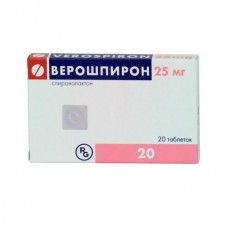Expiration date: 05/2030
Active substance: Spironolactone
The drug forms
Tablets: white or almost white, flat, round, beveled, a characteristic odor and labeled «VEROSPIRON» on one side.
The capsule 50 mg: hard gelatine size ?3; cap - opaque, yellow; housing - an opaque, white color.
Capsule 100 mg: hard gelatine size ?0; cap - opaque, orange; housing - an opaque, yellow.
The contents of capsules - a fine-grained granular powder mixture is white.
Pharmachologic effect
Mode of action - Potassium-sparing, diuretic.
Pharmacodynamics
Spironolactone is a potassium-sparing diuretic, a specific antagonist of aldosterone (a hormone of the adrenal cortex mineralokortikosteroidny) prolonged action. In the distal nephron spironolactone prevents aldosterone delay sodium and water and inhibits the effect of aldosterone kaliyvyvodyaschy, reduces the synthesis permeases in aldosteronzavisimom site collecting tubules and distal tubules. Aldosterone binding to receptors, increases the excretion of sodium, chloride and water excretion, reduces the excretion of potassium ion and urea reduces the acidity of urine.
Increased urine output due to the presence of the diuretic effect, which is not constant; diuretic effect is manifested in the 2-5-day treatment.
Pharmacokinetics
Absorption and distribution
When ingestion rapidly and completely absorbed from the gastrointestinal tract. Associated with the plasma protein by about 98% (canrenone - 90%). Tmax plasma canrenone -. 4.2 hours after the daily administration of 100 mg spironolactone for 15 days achieves Cmax 80 ng / mL, Tmax, after receiving the next morning - 2.6 hr Vd -. 0,05 l / kg.
Metabolism
Spironolactone is transformed into active metabolites: metabolite containing sulfur (80%) and partially - in canrenone (20%). Spironolactone bad into the organs and tissues, while it and its metabolites cross the placental barrier and canrenone - in breast milk.
Breeding
Excreted by the kidneys: 50% - in the form of metabolites, 10% - unchanged, and partly through the intestines. T1 / 2 spironolactone - 13-24 hours, active metabolites - 15 hours Excretion canrenone (mainly kidneys) biphasic, T1 / 2 in the first phase -. 2.3 hours, in the second - 12-96 h.
In cirrhosis of the liver and heart failure: the duration of T1 / 2 increases with no signs of accumulation, the probability is higher in patients with chronic renal failure and hyperkalemia.
Testimony:
- essential hypertension (as part of combination therapy);
- edema syndrome in patients with chronic heart failure (can be used as monotherapy and in combination with standard therapy);
- conditions that can be detected secondary hyperaldosteronism, including cirrhosis of the liver, accompanied by ascites and / or edema, nephrotic syndrome, and other conditions involving swelling;
- hypokalemia / hypomagnesemia (as an aid to prevent it during treatment with diuretics and inability to use other methods of potassium level correction);
- Primary hyperaldosteronism (Conn's syndrome) - for a short pre-operative treatment;
- diagnosis of primary hyperaldosteronism.
Contraindications
- hypersensitivity to any component of the drug;
- Addison's disease;
- hyperkalemia;
- hyponatremia;
- severe renal impairment (Cl creatinine <10 ml / min), anuria;
- pregnancy;
- lactation;
- Children under 3 years of age;
- lactase deficiency, lactose intolerance, glucose-galactose malabsorption.
Precautions: hypercalcemia; metabolic acidosis; AV block (hyperkalemia contributes to its strengthening); diabetes (with confirmed or suspected chronic renal failure); diabetic nephropathy; Surgical intervention (during anesthesia); receiving drugs that cause gynecomastia; local and general anesthesia; elderly age; menstrual disorders, breast enlargement; liver failure; cirrhosis of the liver.
Pregnancy and breast-feeding
Contraindicated during pregnancy and lactation. It should stop breast-feeding in case of impossibility to cancel spironolactone.
Side effects
On the part of the digestive tract: nausea, vomiting, diarrhea, ulceration and bleeding from the gastrointestinal tract, gastritis, intestinal colic, abdominal pain, constipation.
Liver: abnormal liver function.
CNS: ataxia, confusion, dizziness, headache, drowsiness, lethargy, confusion, muscle spasm.
From the hematopoietic system: agranulocytosis, thrombocytopenia, megaloblastoz.
Laboratory parameters: hyperuricemia, hypercreatininemia, increasing concentrations of urea, a violation of water-salt balance (hyperkalemia, hyponatremia) and acid-base balance (metabolic acidosis or alkalosis hyperchloraemic).
From endocrine system: deepening of voice; men - gynecomastia (development of probability depends on the dose, duration of treatment and usually is reversible), decreased potency and erection; in women - menstrual disorders, dysmenorrhea, amenorrhea, metrorrhagia, menopause, hirsutism, pain in the breast, breast carcinoma (a connection with the drug intake is not installed).
When using Veroshpiron the drug may develop gynecomastia. The probability of occurrence of gynecomastia depends on both the dose and duration of therapy. It is usually gynecomastia is reversible and disappears after discontinuation of the drug, and only in rare cases, breast remains somewhat increased.
Allergic reaction: hives; rarely - and maculopapular erythematous rash, drug fever, pruritus, eosinophilia, Stevens-Johnson syndrome, toxic epidermal necrolysis.
With the Skin: alopecia, hypertrichosis.
From the urinary system: acute renal failure.
From the musculoskeletal system: leg cramps.
Interaction
It reduces the effect of anticoagulants (heparin, coumarin derivatives, indandiona) and the toxicity of cardiac glycosides (because the normalization of the potassium level in the blood interferes with the development of toxicity).
Reduces vascular sensitivity to norepinephrine (requires compliance with caution during anesthesia), increases the T1 / 2 of digoxin - possible digoxin toxicity.
It enhances the toxic effects of lithium (due to the decrease in its clearance).
Perhaps enhances the action of non-depolarizing muscle relaxants (eg tubocurarine).
It accelerates metabolism and excretion of carbenoxolone.
SCS and diuretics (benzothiazine derivatives, furosemide, ethacrynic acid) increase and accelerate the diuretic and natriuretic effects.
It enhances the effect of diuretics and antihypertensive drugs.
NSAIDs reduce the natriuretic and diuretic effect, increases the risk of hyperkalemia, but salicylates and indomethacin reduced diuretic effect.
Alcohol (ethanol), barbiturates, narcotics enhance orthostatic hypotension.
The risk of hyperkalemia when taken with potassium supplements, potassium supplements and potassium-sparing diuretics, ACE inhibitors (acidosis), angiotensin II receptor antagonists, cyclosporin.
Ammonium chloride, cholestyramine giperkaliemicheskogo contribute to the development of metabolic acidosis.
Fludrocortisone is a paradoxical increase in tubular secretion of potassium.
It reduces the effect of mitotane.
It enhances the effect of triptorelin, buserelin, gonadorelin.
Dosing and Administration
Inside.
In essential hypertension: a daily dose for adults - usually 50-100 mg once daily and may be increased to 200 mg, and the dose should be increased gradually, 1 every 2 weeks.
To achieve an adequate response to therapy, the drug should be taken at least 2 weeks. If necessary, a dose adjustment.
When idiopathic hyperaldosteronism: 100-400 mg / day.
In marked hypokalemia and hyperaldosteronism: 300 mg / day (maximum 400 mg) for 2-3 hours, while improving the state gradually reduce the dose to 25 mg / day (for tablets).
Hypokalemia / hypomagnesemia: with hypokalemia and / or hypomagnesemia caused by diuretic therapy, - 25-100 mg / day, once or in several stages. The maximum daily dose - 400 mg if oral potassium supplements or other methods of filling the deficit ineffective.
Diagnosis and treatment of primary hyperaldosteronism
As a diagnostic agent for the diagnostic test, short: 400 mg / day, spreading to several doses per day, for 4 days. By increasing the concentration of potassium in the blood during treatment and reduction - after its cancellation, you can assume the presence of primary hyperaldosteronism.
As a diagnostic agent for prolonged diagnostic test: the same dose for 3-4 weeks. Upon reaching the correction of hypokalemia and hypertension can assume the presence of primary hyperaldosteronism.
Preoperative course of therapy Short primary hyperaldosteronism: after diagnosis hyperaldosteronism set with more accurate diagnostic methods should take Veroshpiron 100-400 mg / day, divided into 1-4 daily administration during the period of preparation for surgery. If surgery is not indicated, then Veroshpiron used for long-term maintenance therapy, using the lowest effective dose, which is chosen individually for each patient.
Swelling on the background of nephrotic syndrome: a daily dose for adults - typically 100-200 mg / day. There were no substantive effect on spironolactone pathological process, and therefore the use of this drug is recommended only when other therapies are ineffective.
When edema with chronic heart failure: 100-200 mg / day in 2-3 divided doses daily for 5 days, in combination with loop or thiazide diuretics. Depending on the effect to reduce the daily dose of 25 mg. The maintenance dose is adjusted individually. The maximum dose - 200 mg / day.
Edema amid cirrhosis if the ratio of urine sodium and potassium ions (Na + / K +) is greater than 1, the adult daily dose - 100 mg. If the ratio is less than 1, the daily dose for adults - usually 200-400 mg. The maintenance dose is adjusted individually.
Edema in children: an initial dose in children older than 3 years of 1-3,3 mg / kg, or 30-90 mg / m2 / day in 1-4 reception. After 5 days, and the dose is adjusted as necessary to increase three-fold over the original.
Overdose
Symptoms include nausea, vomiting, dizziness, diarrhea, skin rash, hyperkalemia (paresthesia, muscle weakness, arrhythmia), hyponatremia (dryness of the oral mucosa, thirst, drowsiness), hypercalcemia, dehydration, increase in urea concentration.
Treatment: gastric lavage, symptomatic treatment of dehydration and hypotension. If hyperkalemia is necessary to normalize the water and electrolyte balance with kaliyvyvodyaschih diuretics rapid parenteral administration of dextrose solution (5-20% solution) with insulin 0.25-0.5 units based on 1 g of dextrose; you can enter, if necessary repeatedly. In severe cases, hemodialysis.
Special instructions
Perhaps a temporary increase in urea nitrogen in serum, especially with reduced kidney function and hyperkalemia. Hyperchloraemic possible reversible metabolic acidosis.
In diseases of the kidneys and liver, as well as in the elderly requires regular monitoring of serum electrolytes and renal function.
The drug is difficult to determine digoxin, cortisol and adrenaline in the blood. Despite the lack of direct effect on carbohydrate metabolism, diabetes mellitus, especially with diabetic nephropathy, requires special care (because of the possibility of hyperkalemia).
In the treatment of NSAID should monitor kidney function and blood electrolyte levels. Avoid eating foods rich in potassium.
During treatment, the use of alcohol is contraindicated.
Effect on ability to drive and mechanisms, the work that is associated with a greater risk of injury. In the initial period of treatment is prohibited to drive and engage in activities that require high concentration and psychomotor speed reactions. Time limits set individually.
Release Form
Tablets, 25 mg. The blister aluminum / PVC 20 pcs. 1 blister in carton box.
Capsules of 50 mg and 100 mg. The blister aluminum / PVC 10 pcs. 3 blisters in a carton box.
Storage conditions
The temperature is not above 30 ° C.
Keep out of the reach of children.
The shelf life
5 years.
Do not use beyond the expiration date printed on the package.





